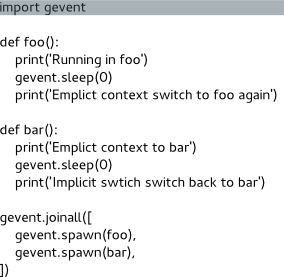相信每一个接触Python并发的同学,刚开始都会有一段困惑时间:Python的并发看起来杂乱无章. 大家使用最多的是threading,但是,Python中由于GIL的存在,又没有实现真正的并发.因此, 在寻求其他并发工具的时候,Python往往由于资料太多,而大家又没有系统性的学习并发,导致 丈二的和尚摸不着头脑.
本文将分别讲解Python中常用的几个并发工具:
- 线程
- 进程
- 线程池/进程池
- 并发执行框架
- Python 3的asyncio
- 开源的gevent

1. Python的threading库
Python通过threading库提供了并发支持,有两种方式可以使用多线程:
- 新建Thread对象
- 继承Thread,然后实现run方法
Python中的多线程使用示例:
#!/usr/bin/python
#-*- coding: UTF-8 -*-
import os
from threading import Thread
def get_data(num):
print('sum to {0} with pid {1}'.format(num, os.getpid()))
return sum([i for i in range(num)])
def main():
data = [ i for i in range(10) ]
threads = []
for num in data:
thread = Thread(target=get_data, args=(num,))
thread.start()
threads.append(thread)
for thread in threads:
thread.join()
if __name__ == '__main__':
main()
2. Python的multiprocessing库
multiprocessing is a package that supports spawning processes using an API similar to the threading module.
可以看到,为了让用户方便的使用多进程,减少用户代码的修改,multiprocessing的API与 threading的API是保持一致的.
例如,对于上面这个并发的例子,只需要将导入语句修改为下面的语句,就能够正常使用多进程:
from multiprocessing import Process as Thread
当然,实际使用中不推荐大家import Process as Thread,这里只是为了说明,这两个包的接口
是一样的,很方便大家进行切换.
3. 线程池/进程池
我们知道,Python里面有一个内置的map函数,该函数是函数式编程语言里面的概念,也是 map-reduce中的map,它的作用就是对一个序列中的每一个元素进行某种操作,例如,求整数的平方:
map(lambda x: x*x, [ i for i in range(5))
内置的map是单线程运行的,如果涉及到网络请求或者大量的cpu计算,则速度相对会慢很多,因此, 出现了并发的map,如下所示:
import requests
from multiprocessing import Pool
def get_website_data(url):
r = requests.get(url)
return r.url
def main():
urls = ['http://mingxinglai.com',
'http://www.baidu.com',
'http://163.com']
pool = Pool(2)
print pool.map(get_website_data, urls)
main()
为了与线程兼容,该模块还提供了multiprocessing.dummy,用以提供线程实现,如下所示:
from multiprocessing.dummy import Pool
4. 并发执行框架
用过java的同学应该知道,java中有ThreadPoolExecutor框架,这类框架特别适合执行一些大批量 的异步任务.
Python3的concurrent.futures模块,提供了Executor框架,类似于java中的ThreadPoolExecutor, 不过,Python中支持两种Executor,分别是:
- ThreadPoolExecutor
- ProcessPoolExecutor
示例如下:
import concurrent.futures
import math
PRIMES = [
112272535095293,
112582705942171,
112272535095293,
115280095190773,
115797848077099,
1099726899285419]
def is_prime(n):
if n % 2 == 0:
return False
sqrt_n = int(math.floor(math.sqrt(n)))
for i in range(3, sqrt_n + 1, 2):
if n % i == 0:
return False
return True
def main():
with concurrent.futures.ProcessPoolExecutor() as executor:
for number, prime in zip(PRIMES, executor.map(is_prime, PRIMES)):
print('%d is prime: %s' % (number, prime))
if __name__ == '__main__':
main()
如果要使用ThreadPoolExecutor,只需要修改一行代码即可:
with ThreadPoolExecutor(max_workers=1) as executor:
5. asyncio
Python 3.4 中asyncio被纳入了标准库,它提供了使用协程编写单线程并发代码,通过IO多路复用 技术访问套接字和其他资源,Python 3.5中添加了async和awit这两个关键字.自此,协程成为新的 语法,而不再是一种生成器类型.
import asyncio
async def slow_operation(n):
await asyncio.sleep(1)
print('Slow operation {} complete'.format(n))
async def main():
await asyncio.wait([
slow_operation(1),
slow_operation(2),
slow_operation(3),
])
loop = asyncio.get_event_loop()
loop.run_until_complete(main())
6. gevent
gevent是一个基于微线程库greenlet的并发框架,其基本思想是:当一个greenlet遇到IO操作时, 比如访问网络,就自动切换到其他的greenlet,等到IO操作完成,再在适当的时候切换回来继续执行. 由于IO操作非常耗时,经常使程序处于等待状态,有了gevent为我们自动切换协程,就保证总有 greenlet在运行,而不是等待IO.
虽然与直接使用greenlet、eventlet相比性能略低,但是,它提供了和线程模型编程相仿的接口, 而且提供了Monkey Patch方法,可以在运行时动态修改标准库里大部分的阻塞式系统调用, 如socket, threading, select等模块.
gevent的好处是Python 2和Python 3都可以使用,不像asyncio只能在python 3中使用.Gevent的使用示例如下:
import gevent
def foo():
print('Running in foo')
gevent.sleep(0)
print('Explicit context switch to foo again')
def bar():
print('Explicit context to bar')
gevent.sleep(0)
print('Implicit context switch back to bar')
gevent.joinall([
gevent.spawn(foo),
gevent.spawn(bar),
])
再强调一遍: 当一个greenlet遇到IO操作时,比如访问网络,就自动切换到其他的greenlet, 等到IO操作完成,再在适当的时候切换回来继续执行.由于IO操作非常耗时,经常使程序处于等待 状态,有了gevent为我们自动切换协程,就保证总有greenlet在运行,而不是等待IO.
所以上段代码的执行流程如下:

总结
本文概要的介绍了Python中的6个并发工具,大家可以通过本文,快速的了解各个工具的使用,选择 适合的工作.